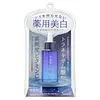What's inside
What's inside
 Key Ingredients
Key Ingredients

 Benefits
Benefits

 Concerns
Concerns

 Ingredients Side-by-side
Ingredients Side-by-side

Water
Skin ConditioningButylene Glycol
HumectantGlycerin
HumectantSqualane
EmollientOctyldodecyl Myristate
EmollientBatyl Alcohol
EmollientDimethicone
EmollientHydrogenated Palm Kernel Oil
EmollientStearic Acid
CleansingPolyglyceryl-10 Distearate
EmulsifyingGlyceryl Stearate
EmollientDipentaerythrityl Tetrahydroxystearate/Tetraisostearate
Skin ConditioningBehenyl Alcohol
EmollientMilk Ferment
Skin ConditioningGlycine Max Seed Extract
Skin ConditioningRetinol
Skin ConditioningSoy Isoflavones
Skin ConditioningRetinyl Palmitate
Skin ConditioningCeramide Ng
Skin ConditioningPEG-60 Hydrogenated Castor Oil
EmulsifyingArginine
MaskingAlcohol Denat.
AntimicrobialCarbomer
Emulsion StabilisingGlycyrrhiza Glabra Root Extract
BleachingXanthan Gum
EmulsifyingCyclodextrin
AbsorbentCyclopentasiloxane
EmollientCeramide AP
Skin ConditioningCeramide NP
Skin ConditioningGlycine Soja Sterols
EmollientTocopherol
AntioxidantElaeis Guineensis Kernel Oil
EmollientPolysorbate 20
EmulsifyingPolysorbate 80
EmulsifyingPolyglyceryl-10 Myristate
Skin ConditioningPhytosteryl/Behenyl/Octyldodecyl Lauroyl Glutamate
Skin ConditioningLecithin
EmollientHydrogenated Lecithin
EmulsifyingMethylparaben
PreservativeWater, Butylene Glycol, Glycerin, Squalane, Octyldodecyl Myristate, Batyl Alcohol, Dimethicone, Hydrogenated Palm Kernel Oil, Stearic Acid, Polyglyceryl-10 Distearate, Glyceryl Stearate, Dipentaerythrityl Tetrahydroxystearate/Tetraisostearate, Behenyl Alcohol, Milk Ferment, Glycine Max Seed Extract, Retinol, Soy Isoflavones, Retinyl Palmitate, Ceramide Ng, PEG-60 Hydrogenated Castor Oil, Arginine, Alcohol Denat., Carbomer, Glycyrrhiza Glabra Root Extract, Xanthan Gum, Cyclodextrin, Cyclopentasiloxane, Ceramide AP, Ceramide NP, Glycine Soja Sterols, Tocopherol, Elaeis Guineensis Kernel Oil, Polysorbate 20, Polysorbate 80, Polyglyceryl-10 Myristate, Phytosteryl/Behenyl/Octyldodecyl Lauroyl Glutamate, Lecithin, Hydrogenated Lecithin, Methylparaben
Tranexamic Acid
AstringentAscorbyl Glucoside
AntioxidantCeramide Ns
Skin ConditioningOryza Sativa Bran Extract
Skin ConditioningPisum Sativum Extract
Skin ConditioningHydrolyzed Conchiolin Protein
Skin ConditioningSilk Extract
Skin ConditioningCoix Lacryma-Jobi Ma-Yuen Seed Extract
Skin ConditioningGlycine Soja Extract
Skin Conditioning1,4-Cyclohexanedicarboxylic Acid
Glycerin
HumectantButylene Glycol
HumectantPolyglycerin-6
HumectantAlcohol Denat.
AntimicrobialPotassium Hydroxide
BufferingPEG-8 Castor Oil
EmulsifyingHedta
AbsorbentPolyvinylalcohol Crosspolymer
Polysorbate 20
EmulsifyingSodium Citrate
BufferingCitric Acid
BufferingSodium Metabisulfite
AntioxidantPhenoxyethanol
PreservativeSodium Paraben
PreservativeWater
Skin ConditioningTranexamic Acid, Ascorbyl Glucoside, Ceramide Ns, Oryza Sativa Bran Extract, Pisum Sativum Extract, Hydrolyzed Conchiolin Protein, Silk Extract, Coix Lacryma-Jobi Ma-Yuen Seed Extract, Glycine Soja Extract, 1,4-Cyclohexanedicarboxylic Acid, Glycerin, Butylene Glycol, Polyglycerin-6, Alcohol Denat., Potassium Hydroxide, PEG-8 Castor Oil, Hedta, Polyvinylalcohol Crosspolymer, Polysorbate 20, Sodium Citrate, Citric Acid, Sodium Metabisulfite, Phenoxyethanol, Sodium Paraben, Water
 Reviews
Reviews

Alternatives
Ingredients Explained
These ingredients are found in both products.
Ingredients higher up in an ingredient list are typically present in a larger amount.
Alcohol Denat. is an alcohol with a denaturant property. It is created by mixing ethanol with other additives.
This ingredient gets a bad rep because it is irritating and drying - mostly due to its astringent property. Astringents draw out natural oils in tissue, constricting pores and leaving your skin dried out.
However, alcohol denat. is not all that bad.
Due to its low molecular weight, alcohol denat. tends to evaporate quickly. One study on pig skin found half of applied alcohol evaporated in 10 seconds and less than 3% stayed on skin.
This also helps other ingredients become better absorbed upon application.
Studies are conflicted about whether this ingredient causes skin dehydration. One study from 2005 found adding emollients to propanol-based sanitizer decreased skin dryness and irritation. Another study found irritation only occurs if your skin is already damaged.
Small amounts of alcohol are generally tolerated by oily skin or people who live in humid environments.
The rule of thumb is if this alcohol is near the end of an ingredients list, it will probably not affect your skin much.
Also...
This ingredient has antimicrobial and solvent properties.
The antimicrobial property helps preserve products and increase their shelf life. As a solvent, it helps dissolve other ingredients.
Other types of astringent alcohols include:
Learn more about Alcohol Denat.Butylene Glycol (or BG) is used within cosmetic products for a few different reasons:
Overall, Butylene Glycol is a safe and well-rounded ingredient that works well with other ingredients.
Though this ingredient works well with most skin types, some people with sensitive skin may experience a reaction such as allergic rashes, closed comedones, or itchiness.
Learn more about Butylene GlycolGlycerin is already naturally found in your skin. It helps moisturize and protect your skin.
A study from 2016 found glycerin to be more effective as a humectant than AHAs and hyaluronic acid.
As a humectant, it helps the skin stay hydrated by pulling moisture to your skin. The low molecular weight of glycerin allows it to pull moisture into the deeper layers of your skin.
Hydrated skin improves your skin barrier; Your skin barrier helps protect against irritants and bacteria.
Glycerin has also been found to have antimicrobial and antiviral properties. Due to these properties, glycerin is often used in wound and burn treatments.
In cosmetics, glycerin is usually derived from plants such as soybean or palm. However, it can also be sourced from animals, such as tallow or animal fat.
This ingredient is organic, colorless, odorless, and non-toxic.
Glycerin is the name for this ingredient in American English. British English uses Glycerol/Glycerine.
Learn more about GlycerinPolysorbate 20 is made by combining ethoxylation of sorbitan, ethylene oxide, and lauric acid. It is a mild cleansing agent, surfactant, and emulsifier.
As a surfactant, it helps collect dirt and oils for washing. Emulsifiers prevent oils and water from separating.
Polysorbate 20 also adds scent to a product. Since it is made using sorbitol, it has a sweet scent. Sorbitol can also be found in fruits such as apples and peaches.
The lauric acid used to create Polysorbate 20 is often derived from coconuts.
Polysorbate 20 may not be fungal acne safe.
Learn more about Polysorbate 20Water. It's the most common cosmetic ingredient of all. You'll usually see it at the top of ingredient lists, meaning that it makes up the largest part of the product.
So why is it so popular? Water most often acts as a solvent - this means that it helps dissolve other ingredients into the formulation.
You'll also recognize water as that liquid we all need to stay alive. If you see this, drink a glass of water. Stay hydrated!
Learn more about Water